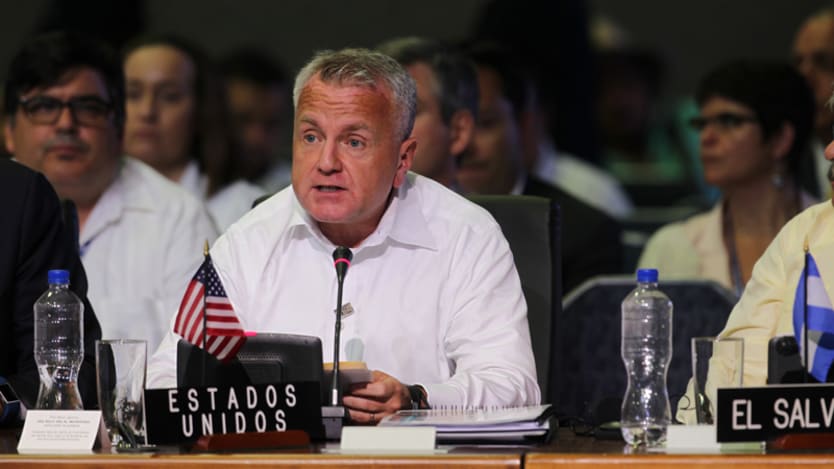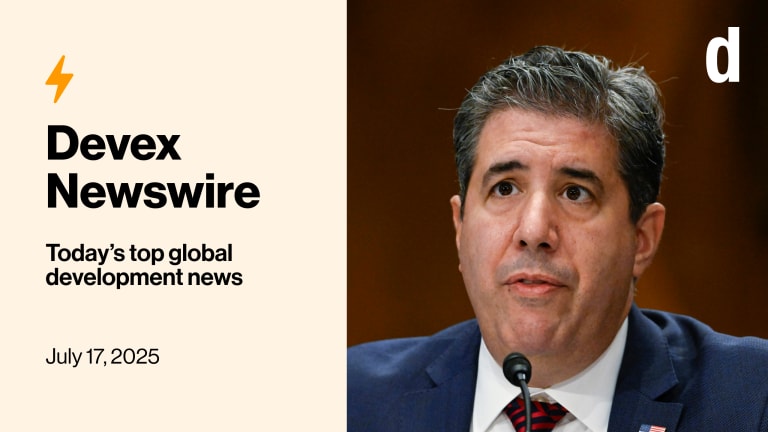
NEW YORK — Deputy Secretary of State John Sullivan fielded questions Tuesday about how the State Department plans to lead more effectively and recruit a more diverse body of employees — all while operating with one-third of its present budget.
President Trump’s proposed budget for State and the U.S. Agency for International Development, released this spring, would drop their funding to about $37.7 billion, down from the approximate $55 billion they received in FY 2017.
Several members of the House Foreign Affairs Committee appeared skeptical that talk of “efficiency is not just code for budget cuts,” as New York Congressman Eliot Engel said in his opening remarks. Morale is low at the State Department, Sullivan conceded during the nearly three-hour hearing in Washington, D.C., which was broadcast online.
“There is uncertainty. We are doing our best to reduce that uncertainty,” he said. The State Department has 75,000 employees worldwide, but about 30 high-level ambassador positions are currently unfilled, including the position of ambassador to key U.S. allies, such as Jordan.
“We have had a town hall meeting, small group meetings, the Secretary [of State Rex Tillerson] has instituted a regular outreach program. We are doing all we can to reassure that the process is employee-led,” he continued as he described a plan that would cut 2,000 jobs over the next several years.
The session offered some clearer indication of how the reform process will likely materialize on a few specific points at State and USAID. Here are our top three takeaways of things to look out for moving forward.
1. Employment with diversity in mind
Members of Congress repeatedly probed Sullivan on the need for more diversity in the State Department. Sullivan, in turn, affirmed his commitment to a department that “reflects America.” Hiring with diversity in mind is a “key goal,” he said.
The number of women in senior foreign and civil service positions in the U.S. government has decreased over the past eight years, Sullivan said.
While women comprise 54 percent of the State Department's civil service, they become outnumbered by men at more senior levels. Representation of black and Asian employees also drops as the positions become more senior.
At one point in his testimony, Sullivan said he envisioned a more “diverse State” that would include “women, minorities, veterans,” and would also be representative of languages, cultures, expertise.”
Currently, the State Department only interviews candidates for the Foreign Service in D.C. or San Francisco. In his most direct commitment to hiring with diversity in mind, Sullivan said that he is considering broadening the base of cities in which prospective candidates can be considered for positions.
Veteran hiring is also a priority. “We are doing all we can for outreach to veterans, but also to other groups as well that are under represented in the State Department,” he said.
2. There’s a need for more humanitarian engagement — but not merging with USAID
Sullivan put one rumor to rest: State is not merging with USAID.
“There are substantial proposals under consideration. However, one of them is not merging USAID with State Department,” he said. “We are not considering merging AID into the State Department.
State also is not planning on changing its mission statement — deviating from the path USAID took recently — to exclude the phrases “democracy promotion” and “human rights.”
The role of USAID, however, “should be more enhanced,” Sullivan said. “It should be more effective, it should be more efficient.”
The food insecurity crises in Nigeria, Somalia, and South Sudan also are not receiving enough support from USAID, Sullivan said. “We are not doing as much as we should be to respond to that,” he said.
Sullivan also expressed support for the 3.5 million people without power in Puerto Rico — an American territory — which is on the brink of a “humanitarian crisis” following widespread destruction brought on by Hurricane Maria, the most powerful hurricane to hit the Caribbean in decades. Trump announced a trip to Puerto Rico on Tuesday, following a belated response to the disaster — and criticism of the island’s poor infrastructure and debt.
3. The reform process won’t happen overnight or easily
Sullivan highlighted the reform goals as aiming to maximize the impact and accountability of foreign assistance; implementing a more effective global service framework, while reducing costs and redundancies; empowering and retaining a strong workforce; and improving IT platforms.
The proposed budget cuts, however, prompted U.S. Rep. Gerry Connolly, a Democrat from Virginia, to question how these changes could happen with a strong cap on spending already in place.
“It [puts a] damper on my enthusiasm to organize the bottom-up effort, because I am worried about my own job security. And I wonder how secure the effort is, if in advance I have already been told what the parameters are,” he said.
Sullivan explained that the “budget parameters” are only one part of the redesign. Connolly pointed out that they are a “pretty big and important one, though, right?”
“To some employees it sounds like empty rhetoric. The fact is we have a president and a budget that would cut a third of their budget, and that does not seem like a high value being put on their work,” Connolly said.
Sullivan said the beginning of implementing certain changes will be done over the next several months, and that the process will be ongoing, and responsive to challenges that arise.
What's the future of U.S. aid and development policy under the Trump administration? Read Devex news and analysis and subscribe to The Development Newswire.
Read more Devex coverage of U.S. foreign policy under Trump:
▶ US aid budget moves forward, but Democrats plan to fight cuts
▶ Trump budget thrusts US foreign aid into a political fight
▶ Budget cuts target development assistance, hint at organizational change
▶ As budget negotiations begin, here's where US Congress stands on foreign aid
▶ No intent to merge USAID into State, says deputy secretary of state








